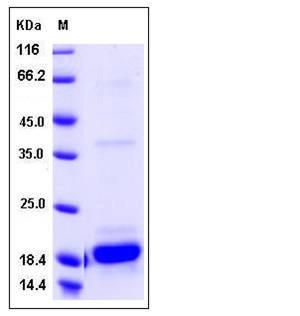Mouse Interleukin-2 / IL-2 Protein
Il-2
- 100ug (NPP3376) Please inquiry
| Catalog Number | P51061-MNAE |
|---|---|
| Organism Species | Mouse |
| Host | E. coli |
| Synonyms | Il-2 |
| Molecular Weight | The recombinant mouse IL2 consists of 150 amino acids and has a calculated molecular mass of 17.4KDa. It migrates as an approximately 19 kDa in SDS-PAGE under reducing conditions. |
| predicted N | Met |
| SDS-PAGE |  |
| Purity | > 92 % as determined by SDS-PAGE |
| Protein Construction | A DNA sequence encoding the soluble form of mouse IL2 (P04351) (Ala 21-Gln 169) was expressed, with an initial Met at the C-terminus. |
| Bio-activity | 1. Measured by its ability to bind recombinant human IL2Ra-Fc (P10165-H02H) in a functional ELISA. 2. Measured in a cell proliferation assay using CTLL2. The ED50 for this effect is typically 0.2-1.0 ng/mL. |
| Research Area | Neuroscience |Neurology process |Neuroinflammation |
| Formulation | Lyophilized from sterile PBS, 2mM DTT, pH 7.4 1. Normally 5 % - 8 % trehalose and mannitol are added as protectants before lyophilization. Specific concentrations are included in the hardcopy of COA. |
| Background | Interleukin-2, also known as T-cell growth factor, TCGF, Aldesleukin and IL2, is a secreted protein which belongs to the IL-2 family. Interleukin-2 / IL-2 was the first interleukin molecule to be discovered. Interleukin-2 / IL-2 molecule was first purified to homogeneity by immunoaffinity chromatography by Kendall Smith and his team at Dartmouth Medical School. Interleukin-2 / IL-2 was also the first cytokine shown to mediate its effects via a specific IL-2 receptor, and it was also the first interleukin to be cloned and expressed from a complementary DNA (cDNA) library. Interleukin-2 / IL-2 was designated number 2 because Smith's data at the time indicated that IL-1, produced by macrophages, facilitates IL-2 production by T lymphocytes (T cells). Interleukin-2 / IL-2 is produced by T-cells in response to antigenic or mitogenic stimulation, this protein is required for T-cell proliferation and other activities crucial to regulation of the immune response. Interleukin-2 / IL-2 is normally produced by the body during an immune response. When environmental substances (molecules or microbes) gain access to the body, these substances (termed antigens) are recognized as foreign by antigen receptors that are expressed on the surface of lymphocytes. Antigen binding to the T cell receptor (TCR) stimulates the secretion of Interleukin-2 / IL-2, and the expression of IL-2 receptors IL-2R. The IL-2 / IL-2R interaction then stimulates the growth, differentiation and survival of antigen-selected cytotoxic T cells via the activation of the expression of specific genes. Interleukin-2 / IL-2 can stimulate B-cells, monocytes, lymphokine-activated killer cells, natural killer cells, and glioma cells. The World Reference Standard for Interleukin-2 / IL-2 is produced by the National Institute of Biological Standards and Control in the UK. A recombinant form of Interleukin-2 / IL-2 for clinical use is manufactured by Chiron Corporation with the brand name Proleukin. It has been approved by the Food and Drug Administration (FDA) for the treatment of cancers (malignant melanoma, renal cell cancer), and is in clinical trials for the treatment of chronic viral infections, and as a booster (adjuvant) for vaccines. The use of Interleukin-2 / IL-2 in HIV therapy has been found to be ineffective. |
| Reference |
